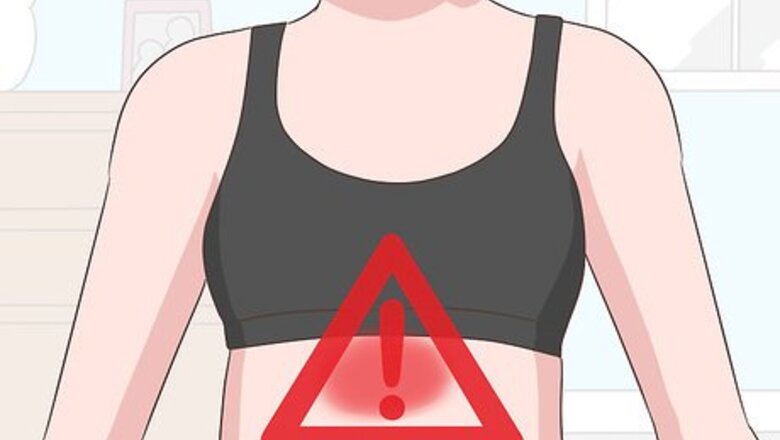
views
- Go to your doctor if you're experiencing bleeding ulcer symptoms like upper abdominal pain, nausea, and blood in your vomit or stool.
- Your doctor will prescribe medication that blocks acid production to heal the ulcer. Take the medication as directed.
- For serious bleeding ulcers, you may need to have a surgical procedure to close the ulcer and stop the bleeding.
Noticing Symptoms of a Bleeding Ulcer
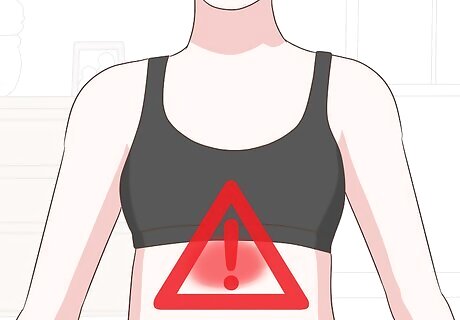
Pay attention to upper abdominal pain. If you have a peptic or bleeding ulcer, you may notice moderate burning pain in your middle upper abdomen, which is between your belly button and breast bone. The pain may come and go throughout the day, but will typically be worst immediately after you’ve eaten. The ulcer may also be painful when you haven’t eaten for a few hours and your stomach is empty. Essentially, pain from your ulcer is likely to be at its worst when the stomach is either very empty or very full.
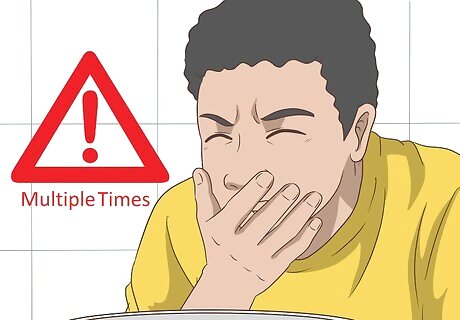
Note recurring feelings of nausea. Feeling nauseous a single time is not a conclusive symptom, but if you find yourself feeling nauseous multiple times in a week, or even more than once a day, you may have a bleeding ulcer. Your stomach may also feel bloated, with or without the accompanying symptom of nausea. The amount of blood coming from the ulcer will influence the mildness or severity of the nausea or bloating. Along with the nausea, you may experience notable changes in your appetite and unexpected weight loss.
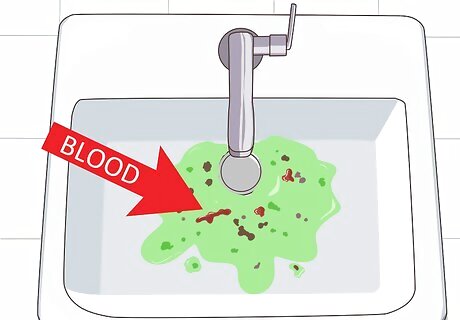
Look for blood in your vomit. A bleeding ulcer irritates the stomach and fills it with blood, which often results in nausea and vomiting. In most cases, blood will have approximately the consistency and texture of coffee grounds. Even if you do not see blood in your vomit, frequent vomiting itself can be a sign of a peptic ulcer. Seek immediate medical attention if you see blood or a coffee-like substance in your vomit, as this is a medical emergency. In addition to nausea and vomiting, individuals with ulcers also often experience heartburn and an intolerance to fatty foods.
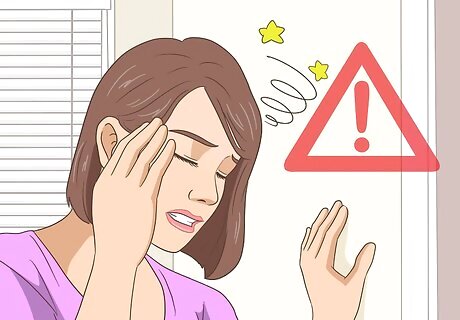
Pay attention to symptoms of anemia. If your ulcer is not producing much blood, the previously mentioned symptoms may not affect you. In these cases, the first sign of a bleeding ulcer can be anemia. Symptoms of anemia include lightheadedness and continual fatigue. You may also feel a shortness of breath, or notice that your skin is pale in color. Anemia results from an insufficient amount of blood circulating in your body.
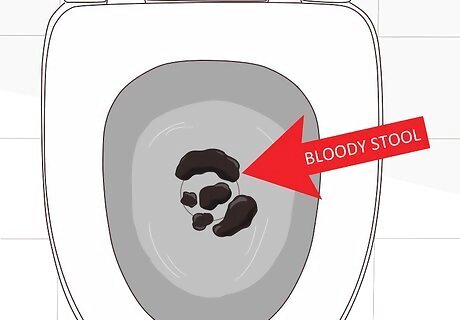
Notice any blood in your stool. If you have a bleeding ulcer, you can usually tell by looking at your stool. Bloody stool is dark in color (nearly black), and looks thick and sticky. It's called tarry stool. The visual texture of bloody stool is compared to that of roofing tar.
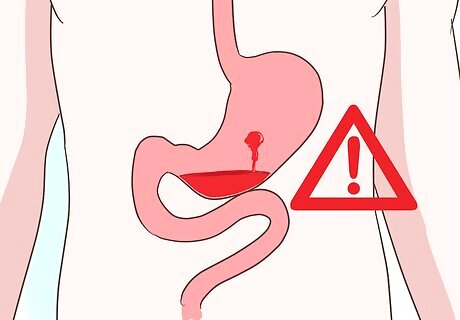
Visit an emergency room if you have a hemorrhaging ulcer. A severely bleeding ulcer can produce internal hemorrhaging, which is a medical emergency. This results in the loss of a dangerous amount of blood. A hemorrhaging ulcer can be life threatening. If you have think you may have a hemorrhaging ulcer, visit an Urgent Care center or an emergency room immediately. Signs of a hemorrhaging ulcer include: severe upper abdominal pain, extreme weakness or fatigue, and large amounts of blood in your stool and vomit. Blood in your stool usually will not look red. Instead, blood causes black, tar-like stools.
Talking to Your Doctor
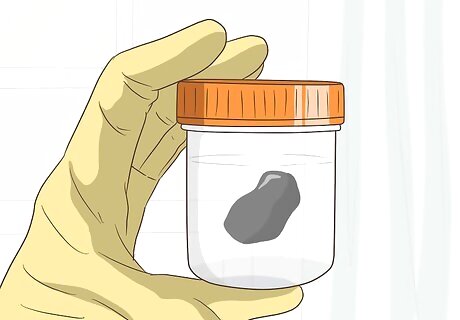
Bring your doctor a stool sample. To take the stool sample, defecate, and then use a clean spoon or other utensil to deposit the stool in a sealable plastic bag or container provided by a doctor. The stool sample should be about the size of a walnut. If you can’t take the stool sample to the doctor immediately after producing it, store the sample in your refrigerator. The doctor will test your stool for blood, which can indicate the presence of a bleeding ulcer in your stomach or small intestine.
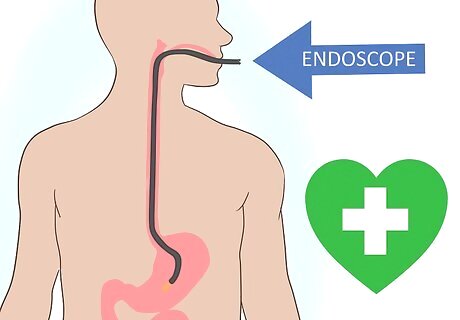
Consent to receiving an endoscopy from your doctor. An endoscopy is the primary medical procedure used to examine a bleeding ulcer. During an endoscopy, a small tube with a camera attached is inserted down your esophagus and into your stomach. This allows doctors to look inside your stomach and inspect the lining for a bleeding ulcer. An endoscopy may produce some discomfort while the tube is passed down your throat and into your stomach. The procedure is not painful, though, and you may not be given an anesthetic. However, your doctor may give you a medication to relax you. Talk to your doctor before the procedure to discuss any premedication that you will be given. While the doctor is doing your endoscopy, they may also take a biopsy. In place of an endoscopy, your doctor may perform an upper gastrointestinal series. This procedure involves taking a series of X-rays of your stomach and small intestine.
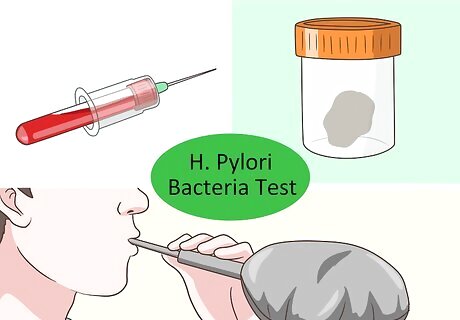
Ask your doctor about medical tests for H. pylori bacteria. To test for H. pylori, doctors will administer a stool, breath, or blood test. If they are administering the breath test, your doctor will ask you to inhale a gas that breaks down H. pylori bacteria in your stomach, and then to exhale into a sealed bag. Your breath in the bag will be analyzed for the bacteria. H. pylori is an abrasive bacteria that can harm the lining of your stomach. Its presence in your stomach is a good indication that you have a peptic or bleeding ulcer. Your doctor can treat H. pylori bacteria with an antibiotic.
Healing the Ulcer with Medical Treatments
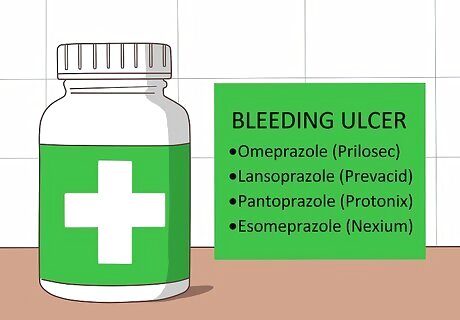
Ask about a prescription for medications that block acid production. If your doctor determines that you do have a bleeding ulcer, they will prescribe you 1 or more medications to help the ulcer heal. The most often prescribed medications are those that block the production of stomach acid. A less acidic environment will allow the ulcer to heal on its own. Commonly prescribed medications include: Omeprazole (Prilosec). Lansoprazole (Prevacid). Pantoprazole (Protonix). Esomeprazole (Nexium).
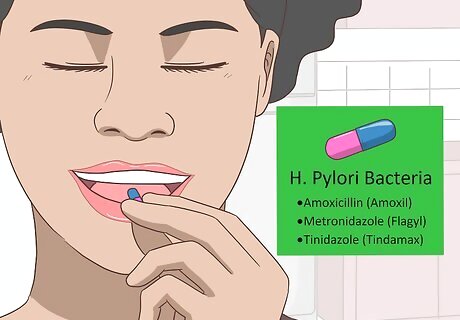
Take medications to kill H. pylori bacteria. If your breath, blood, or stool test for H. pylori came back positive, your doctor can prescribe you an antibiotic medication to remove the bacteria from your system. This will remove the primary irritant within your stomach, and allow the lining of your stomach wall to begin healing itself. Medications commonly prescribed to kill H. pylori include: Amoxicillin (Amoxil). Metronidazole (Flagyl). Tinidazole (Tindamax). If the doctor doesn’t mention the test results to you, make a point to ask them. The test results should be available within a few hours of when you took the test, or 24 hours at the longest.
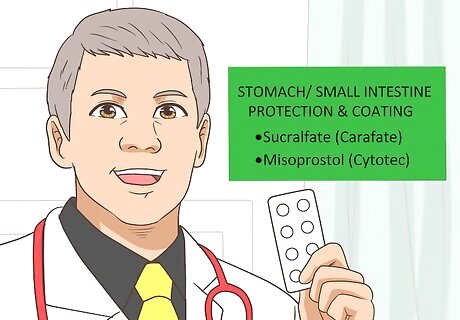
Ask about medications to protect the lining of your stomach or small intestine. If you have a bleeding ulcer, your doctor will prescribe medicine to coat and protect the lining of your stomach or intestine. This will prevent the ulcer from being agitated further, and give the ulcer time to stop bleeding and heal itself. Common prescriptions include: Sucralfate (Carafate). Misoprostol (Cytotec). Your doctor may suggest a different medication based on whether your bleeding ulcer is located in your stomach or your small intestine.

Undergo surgery to close the ulcer. For serious bleeding ulcers, you may need to have a surgical procedure done to close the ulcer and stop the bleeding. Although it’s uncommon, ulcers are occasionally unable to heal themselves. In these cases, a surgeon will need to perform one or more operations to ensure that the ulcer stops bleeding and properly heals. There are three primary surgical procedures performed on individuals with a severely bleeding ulcer. In a vagotomy, the vagus nerve (the nerve that connects the stomach to the brain) is severed. This interrupts the messages the brain sends to the stomach to produce stomach acid. An antrectomy procedure removes the lower portion of the stomach to inhibit the production of stomach acid. In a pyloroplasty, the lower stomach is widened to allow food to process more easily into the small intestine.
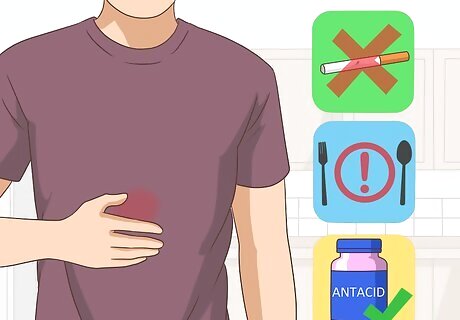
Deal with ulcer-related pain while your body heals. After you begin taking medication, you may still experience discomfort or pain from the ulcer. You can combat this pain in various ways. Your doctor may recommend that you regularly take an antacid for the pain, or that you stop smoking. Your diet can also have an effect on ulcer pain, so if you notice that certain foods irritate the ulcer, stop eating them. Also, try eating 5 to 6 small meals during the day, so that you avoid stuffing your stomach or letting it get completely empty. Talk to your doctor if pain persists for more than 3 or 4 weeks after you began taking medication for your ulcer. The doctor may recommend that you stop taking certain nonsteroidal anti-inflammatory drugs (NSAIDs) that can irritate the ulcer.



















Comments
0 comment